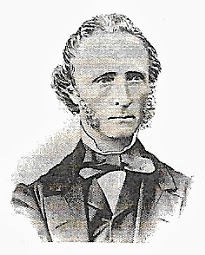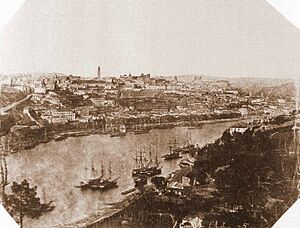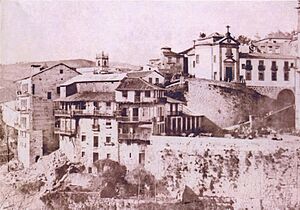Frederick William Flower facts for kids
Quick facts for kids
Frederick William Flower
|
|
|---|---|
 |
|
| Born | 22 February 1815 Leith, Scotland
|
| Died | 18 July 1889 (aged 74) Porto, Portugal
|
| Nationality | British; |
| Occupation | Wine producer and exporter |
| Known for | Photography pioneer |
Frederick William Flower (born February 22, 1815 – died July 18, 1889) was a talented photographer. He was born in Scotland but later lived in Portugal. Many people see him as one of the very first photographers in Portugal. It's amazing that most of his pictures from 1849 to 1859 are still in great condition today!
Contents
Frederick Flower's Early Life and Move to Portugal
Frederick Flower was born on February 22, 1815, in Leith, Scotland. His father was working there at the time. When Frederick was still very young, his family moved back to England. They lived in a town called Hull.
In 1834, Frederick sailed from Hull to Porto, Portugal. He started a job with a company called Smith Woodhouse & Company. This company sold Port wine, a special type of wine. It was common for young English workers to live with the company owner. So, Frederick stayed with Robert Woodhouse, who owned the company.
Family Joins Frederick in Portugal
After his father passed away, Frederick's mother, brother, and two younger sisters joined him in Portugal. This happened in 1836. The family settled together in their new home.
Frederick Flower: A Photography Pioneer
We don't know exactly when Frederick Flower started taking photos. We also don't know where he learned his skills. But he became one of the first people in Portugal to use new photography methods.
Early Photography Techniques
Frederick used techniques called salted paper and calotype processes. These were developed by Henry Fox Talbot in England. This was in the late 1830s. Frederick made most of his calotype photos between 1853 and 1858. He was also a pioneer in Portugal for using strip photography. This was a new way to take pictures.
It's likely that Frederick got his photography supplies from British companies. They probably sent instructions along with the supplies.
Flower's Photographic Work
Frederick Flower even made his own photographic emulsion. This is a special chemical mix used to capture images. He was known to sometimes add touches to his negatives. This helped him create cool artificial cloud effects in his pictures.
Most of his photos were taken in Porto. He also photographed Vila Nova de Gaia. This town is on the other side of the Douro River. Many port wine companies were located there. But Frederick also traveled a lot in northern Portugal. His photographs are very important. They show us what everyday life was like in Portugal during that time.
Preserving and Showing Flower's Photographs
In 1874, Frederick briefly went back to England. This was for health reasons. But he and his wife soon returned to Porto. He passed away there on July 18, 1889.
For over 100 years, Frederick Flower's family kept his photographs safe. Later, they gave them to the National Photography Archive of Portugal. This archive is part of the General-Directorate of Cultural Heritage.
Family Efforts to Preserve History
In 1928, Frederick's grandson, Harold M. Flower, had new prints made. These were from the original calotype negatives. Harold then traveled around northern Portugal. He wanted to find the exact places his grandfather had photographed. The family took great care of the photos. They also collected stories and memories about Frederick.
Even though the Flower family was Anglo-Portuguese, they never sent the photos to England. If a family member moved to England, they would leave the collection with another family member in Portugal. The original calotype negatives are mostly in good shape. However, some of the prints have not lasted as well.
Flower's Photos Become Famous
Because his family kept the photos, Frederick Flower was not very well known in Portugal. Only a few magazine articles mentioned him. But this changed after the Portuguese government bought his photographs.
In 1994, an exhibition was held in Lisbon. It was at the National Museum of Contemporary Art. This exhibition showed all of Flower's amazing work. The collection has 216 calotypes and 101 salted paper prints. There are also later prints.
This allowed people to truly appreciate his photos. They were seen not just as historical records, but also as beautiful art. Experts noted Frederick's great technical skills. They also saw how he experimented with different photography methods.



